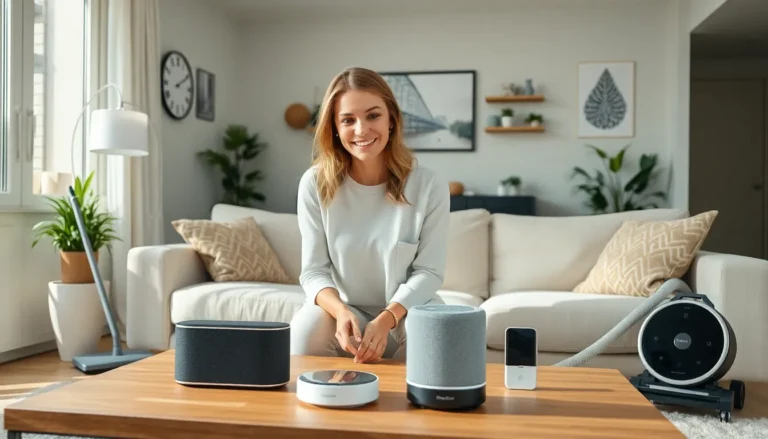In the epic showdown of MacBook vs Windows laptop, tech enthusiasts often find themselves divided like fans at a football game. On one side, the sleek, minimalist design and user-friendly interface of MacBooks woo creative professionals and casual users alike. On the other, Windows laptops boast versatility and a wider range of options, making them the go-to choice for gamers and business moguls.
But let’s face it—choosing between these two titans isn’t just about specs and features. It’s a battle of lifestyles, preferences, and sometimes even a little brand loyalty. Will you embrace the chic elegance of Apple or revel in the customizable world of Windows? Buckle up as we dive into the quirks and perks of each, helping you make a decision that’ll have you typing away in blissful harmony.
Table of Contents
ToggleOverview of MacBook and Windows Laptops
MacBooks and Windows laptops represent significant choices in today’s technology landscape. MacBooks, developed by Apple, are known for their sleek design and premium build quality. Creative professionals often favor these devices because of their intuitive user interface and powerful performance in graphic-intensive applications.
Windows laptops, manufactured by various brands, offer an extensive range of options. These devices cater to different users, from gamers to business professionals, owing to their adaptability and customizable hardware configurations. Performance varies widely, allowing users to select laptops that meet specific needs.
Operating systems differ significantly between the two. macOS runs exclusively on MacBooks, providing a seamless experience for Apple users. In contrast, Windows offers a versatile platform compatible with numerous software applications, appealing to a broader audience.
Price points also diverge. MacBooks typically elevate the cost due to their quality and brand reputation. Windows laptops, however, exist across a larger price spectrum, making them accessible to various budgets.
Specifications play a critical role in decision-making. MacBooks often feature proprietary components optimized for performance and energy efficiency. Windows laptops allow users to choose from diverse components, enabling personalization according to individual preferences.
When considering support and updates, MacBooks benefit from regular macOS updates, ensuring security and performance enhancements. Windows laptops require more diverse management, as support and updates depend on the manufacturer.
Both MacBooks and Windows laptops excel in distinct areas, catering to different user needs and preferences. Understanding these key differences aids in making an informed choice that aligns with personal or professional requirements.
Design and Build Quality
The design and build quality of devices significantly impact user experience. MacBooks exhibit a minimalist aesthetic complemented by high-quality materials. Aluminum unibody construction enhances durability while maintaining a sleek profile. Retina displays provide stunning visuals, making them appealing for graphics work. Keyboards on MacBooks possess a refined layout, offering a tactile response favored by many users. Port placement minimizes cable clutter, contributing to a tidy workspace.
MacBook Design Features
MacBook design prioritizes elegance and simplicity. The sleek chassis features minimal branding, allowing for a sophisticated look. Users appreciate the thin profile, enhancing portability without compromising on performance. An integrated touchpad delivers precise navigation, enhancing workflows, especially for creative tasks. Furthermore, the backlit keyboard ensures usability in low-light conditions, addressing various user needs.
Windows Laptop Design Features
Windows laptops showcase diverse design options catering to different preferences. Various manufacturers create models ranging from ultra-slim ultrabooks to robust gaming rigs. Many offer customizable features, enabling users to select colors and materials. Practicality often influences design, with numerous laptops featuring convertible or detachable screens for versatility. Additionally, significant emphasis on thermal management promotes performance stability during intensive tasks.
Performance Comparison
Performance encompasses various aspects, including processing power and battery life. Understanding these factors helps users decide between MacBooks and Windows laptops.
Processing Power
MacBooks integrate Apple’s M1 or M2 chips, ensuring robust performance for design applications and multitasking. Users appreciate smooth operation in video editing and graphic design. Windows laptops, however, offer a diverse range of processors from Intel and AMD, catering to different demands. Gamers often prefer high-end models featuring dedicated GPUs for advanced graphics rendering. Most entry-level Windows laptops still deliver adequate performance for everyday tasks like browsing and word processing.
Battery Life
MacBooks gain favorable reviews for impressive battery life, often lasting up to 20 hours on a single charge depending on usage patterns. Users frequently report all-day performance without needing a power source. Windows laptops present mixed results in battery longevity, varying significantly across models. Some premium ultrabooks compete closely with MacBook battery life, while budget options may only last around 5 to 8 hours. Ultimately, the choice of device often hinges on the specific user requirements regarding performance and runtime capabilities.
Software and User Experience
The software and user experience on MacBooks and Windows laptops differ significantly. macOS provides a streamlined user experience tailored for Apple hardware, emphasizing efficiency and simplicity.
macOS Advantages
Offering seamless integration with Apple services, macOS allows users to sync their devices effortlessly. Security features enhance the system’s resilience against malware, strengthening overall protection. Regular updates ensure users benefit from the latest features and security patches. Customization options, while limited, encourage a cohesive aesthetic across applications. A well-optimized ecosystem supports creative software like Final Cut Pro and Logic Pro, which appeals to professionals in design and media fields.
Windows OS Advantages
Windows provides extensive software compatibility, catering to a wide variety of applications across industries. Flexibility in hardware choices allows users to select devices that match their specific needs, whether for gaming or business. Frequent updates keep features current while addressing vulnerabilities. Extensive customization options let users modify their environments extensively, enhancing functionality. A vast array of peripherals supports diverse configurations, making Windows laptops highly adaptable for various user scenarios.
Price and Value
Price points represent a crucial factor in the comparison between MacBooks and Windows laptops. Many considerations affect perceived value, including build quality, brand reputation, and specifications.
MacBook Pricing
MacBooks typically fall into the higher price range, commonly starting around $999 for entry-level models. Premium configurations, particularly those with enhanced storage or processing capabilities, can exceed $2,000. Consumers often cite the investment in quality design, superior performance, and longevity as key reasons for choosing MacBooks. Resale value also retains strength, often resulting in higher returns compared to many Windows counterparts. This trend reflects brand loyalty and perceived reliability among users.
Windows Laptop Pricing
In contrast, Windows laptops offer a significantly broader price spectrum that can range from $200 to over $3,000. Budget-friendly options attract students and casual users, while high-end models cater to gamers and business professionals. Different manufacturers provide various pricing tiers, allowing buyers to select devices that meet their performance needs without overspending. Discounts and sales frequently emerge with Windows laptop purchases, enhancing affordability. This variety ensures that consumers find a device tailored to their specific requirements and budget constraints.
Conclusion
Choosing between a MacBook and a Windows laptop ultimately depends on individual needs and preferences. Those who value design and a seamless user experience may lean towards MacBooks, while users seeking versatility and a wide range of options might prefer Windows laptops.
Price considerations also play a significant role in this decision. With MacBooks generally positioned at a higher price point, they attract users willing to invest in premium quality. On the other hand, the extensive variety of Windows laptops ensures that there’s something for everyone, regardless of budget.
Understanding the differences in performance, software compatibility, and design can guide users toward the right choice. Whether for work, gaming, or casual use, both platforms have unique strengths that cater to diverse lifestyles.



